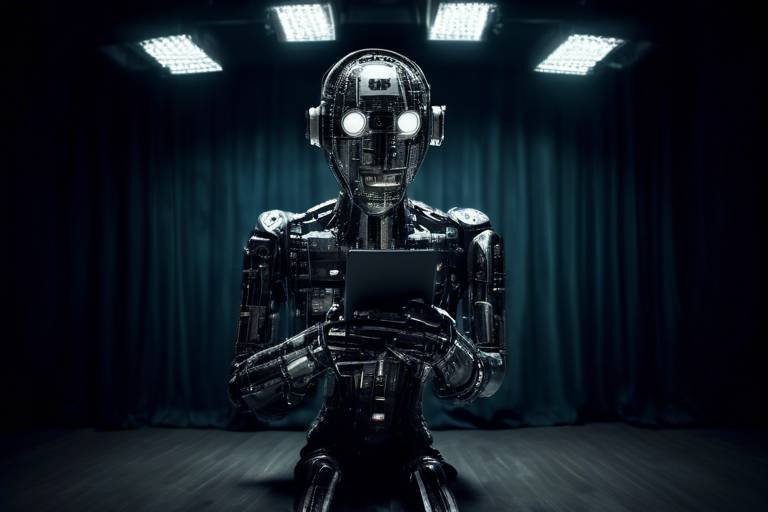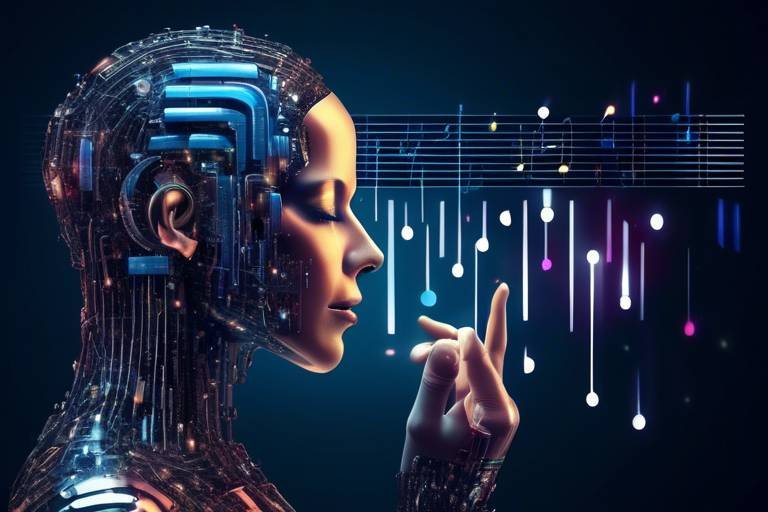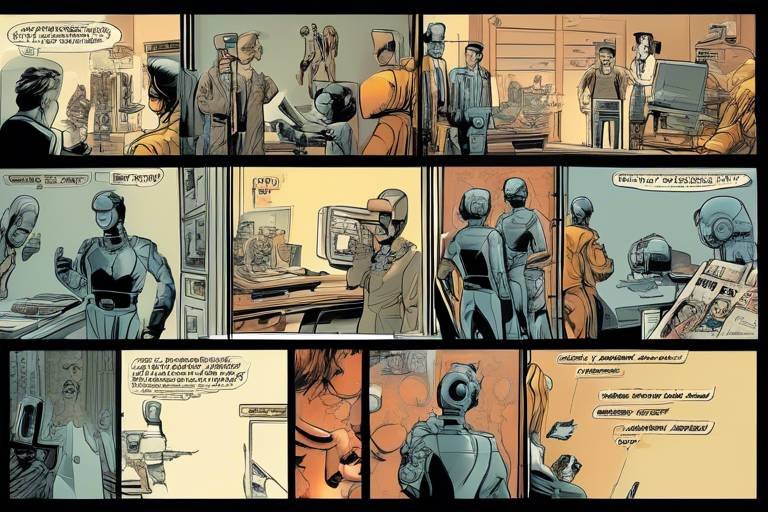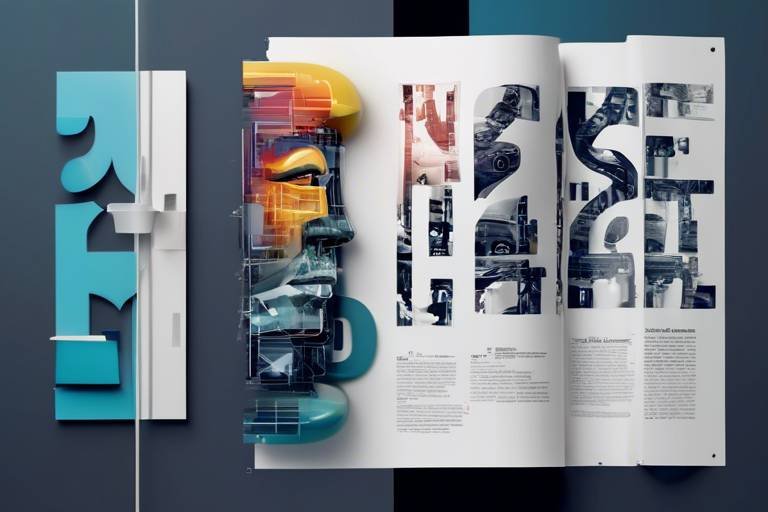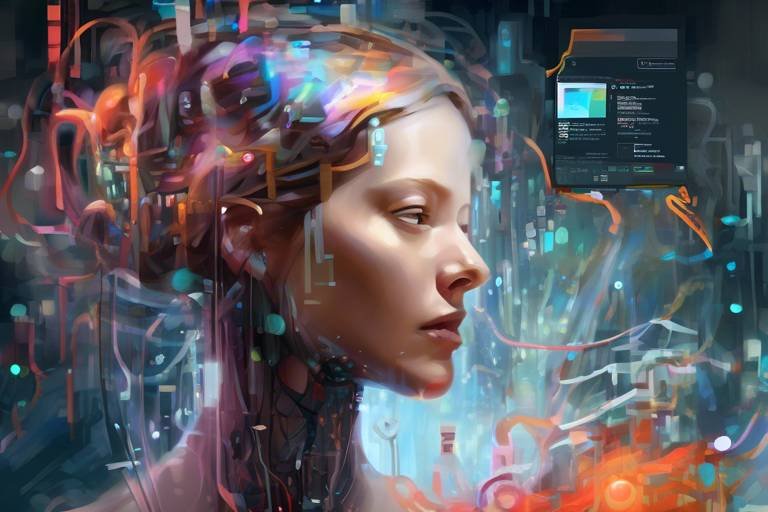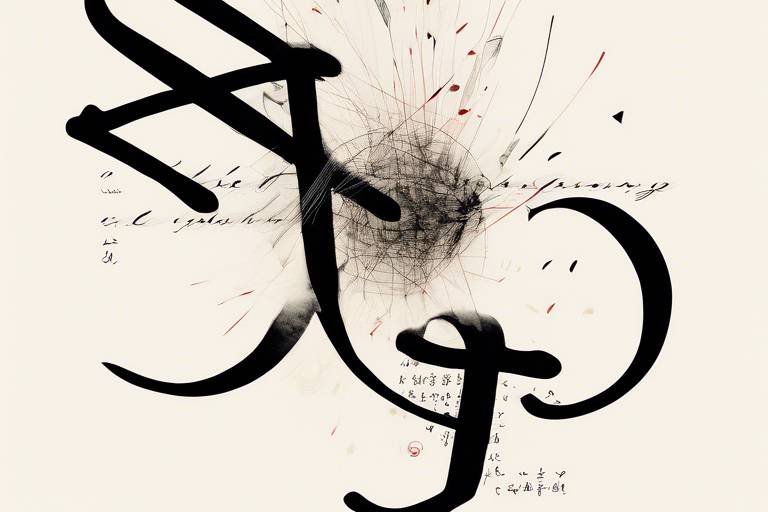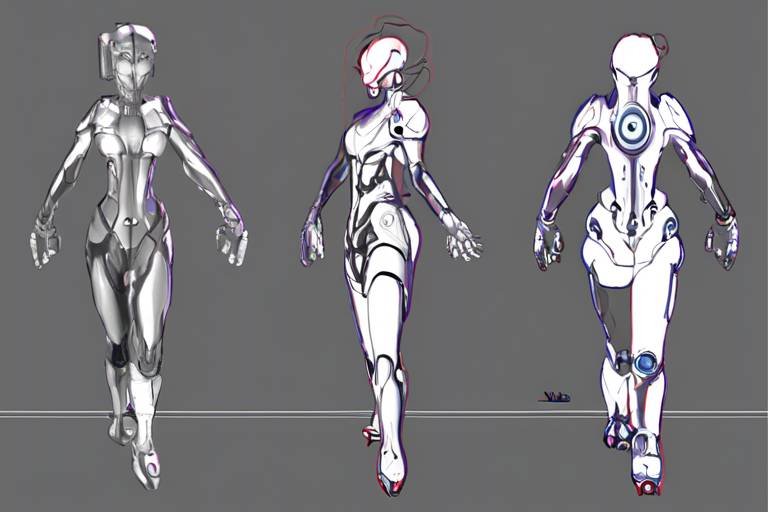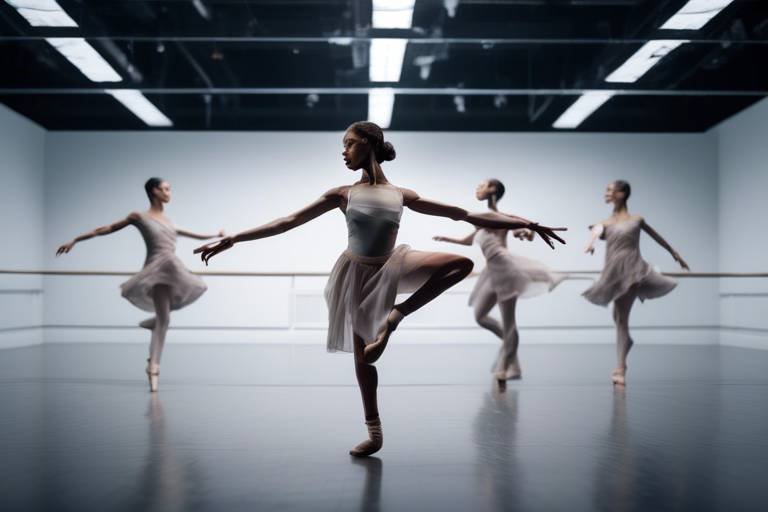Monologues and AI: When Technology Meets Theater
In a world where technology reshapes every aspect of our lives, the realms of theater and performance art are no exception. The emergence of artificial intelligence (AI) has sparked a revolution in how we create and experience monologues, providing a fresh lens through which to view storytelling. Imagine a stage where the lines between human creativity and machine-generated content blur, creating a tapestry of narratives that are both familiar and astonishingly new. This article dives deep into the intersection of AI and theater, exploring how this cutting-edge technology is transforming monologues and the broader creative process.
Monologues have long been a cornerstone of theatrical expression, allowing characters to spill their innermost thoughts and emotions directly to the audience. From the poignant soliloquies of Shakespeare to the raw confessions of contemporary playwrights, these powerful speeches have evolved dramatically over the centuries. Historically, monologues served not just as a narrative device but as a means to establish a deep connection between the character and the audience. Think of Hamlet’s "To be, or not to be"—a moment that resonates through time, capturing the essence of human struggle.
Today, monologues have adapted to reflect modern sensibilities, often incorporating elements of multimedia and interactive storytelling. The rise of digital platforms has expanded the reach of these performances, allowing for innovative interpretations that challenge traditional forms. As we move further into the 21st century, the integration of AI into this evolution is set to redefine what a monologue can be, pushing boundaries and inviting audiences to engage with narratives in unprecedented ways.
Artificial intelligence is not just a buzzword; it’s a game-changer for scriptwriting. Writers are increasingly turning to AI tools to generate dialogue and monologues that not only entertain but also provoke thought. Imagine a scenario where an AI analyzes thousands of scripts, learning the nuances of character development and emotional arcs, then crafts a monologue that feels both fresh and authentic. This is no longer the stuff of science fiction—it’s happening right now!
One of the most exciting aspects of AI in theater is its ability to create characters with unique voices and backgrounds. These AI-generated characters can enhance monologues by adding layers of complexity and depth that might be challenging for human writers alone. For instance, an AI could generate a character based on a specific set of traits, cultural backgrounds, or even historical contexts, resulting in monologues that resonate with diverse audiences.
However, this innovation brings with it a set of challenges, particularly regarding authenticity. Can a machine truly understand the emotional weight behind a character's words? While AI can generate compelling content, it often lacks the human experience that imbues monologues with emotional resonance. Audiences may find themselves questioning the source of a monologue—does it come from a place of genuine human experience, or is it merely a clever algorithm at work? This tension between AI-generated and human-authored content is a crucial conversation in the world of theater today.
Despite these challenges, the potential for collaboration between human writers and AI tools is vast. Writers are beginning to experiment with AI as a co-creator, using it to brainstorm ideas, refine dialogue, and even develop entire scenes. This collaborative approach can lead to innovative monologues that push creative boundaries and challenge conventional storytelling methods. The future of scriptwriting may very well lie in this partnership, where human intuition meets machine intelligence.
AI's influence extends beyond the writing desk; it is making waves in performance art as well. Imagine a live performance where an AI system interacts with actors in real time, adapting the script based on audience reactions. This dynamic interplay creates a unique theatrical experience that evolves with each performance, making every show a one-of-a-kind event. The integration of AI technologies into live performances not only enhances the storytelling but also redefines the role of the performer, transforming them into collaborators with their digital counterparts.
As we look ahead, the future of theater appears to be intricately linked with advancements in AI. Trends indicate that we may see even more innovative uses of technology, from immersive experiences that utilize virtual reality to AI-generated narratives that challenge our perceptions of authorship and creativity. The possibilities are as exciting as they are limitless, sparking a new era of storytelling that invites audiences to engage with the art form in ways they never thought possible.
Engaging audiences through interactive AI experiences is becoming more common, creating immersive environments that enhance the impact of monologues. Imagine attending a play where the audience can influence the direction of the story through their choices, facilitated by AI technology. This level of engagement not only deepens the connection between the audience and the performance but also transforms passive viewers into active participants in the narrative journey.
With the integration of AI into theater comes a host of ethical considerations. Questions about authorship, creativity, and the role of human performers are at the forefront of this discussion. As AI systems become more sophisticated, how do we define the line between human creativity and machine-generated content? These concerns will shape the future of the art form, urging creators to navigate the complexities of technology and human expression thoughtfully.
- What is the role of AI in theater? AI is used in various aspects of theater, including scriptwriting, character development, and live performance enhancements.
- Can AI replace human writers? While AI can generate content, it often lacks the emotional depth and authenticity that human writers bring to storytelling.
- How does AI enhance audience engagement? AI can create interactive experiences that allow audiences to influence the narrative, making them active participants in the performance.
- What are the ethical concerns surrounding AI in theater? Key concerns include authorship, creativity, and the potential for AI to overshadow human performers.

The Evolution of Monologues
Monologues have been a cornerstone of theatrical expression for centuries, acting as a powerful tool for characters to reveal their innermost thoughts and emotions. From the grand stages of ancient Greece to the intimate settings of modern-day theaters, monologues have evolved significantly, reflecting the changing landscape of society and the human experience. In classical theater, monologues served not just as a means of storytelling but also as a way to connect the audience with the protagonist's struggles and triumphs. Think of them as a window into the soul of the character, allowing the audience to empathize and engage on a deeper level.
As we moved into the Renaissance, monologues became more intricate and layered, showcasing the complexities of human emotion. Playwrights like Shakespeare elevated the monologue to an art form, using it to explore themes of love, betrayal, and existential angst. His famous soliloquies, such as Hamlet's "To be, or not to be," not only captivated audiences but also invited them to ponder profound philosophical questions. This era marked a shift where monologues were not just about delivering lines, but about crafting a narrative that resonated with the audience's own experiences.
Fast forward to the 20th century, and we see monologues taking on new forms in the realm of performance art and experimental theater. The rise of modernism brought with it a desire to break free from traditional structures, leading to a more fragmented and abstract approach to monologues. Writers like Samuel Beckett challenged the conventions of language and meaning, creating pieces that often left audiences questioning their interpretations. These shifts in style have paved the way for contemporary monologues, which can range from the deeply personal to the wildly absurd, reflecting the diverse voices and stories of our time.
Today, monologues are not confined to the stage. With the advent of technology and digital media, we see them flourishing in various forms, including film, podcasts, and even social media platforms. This democratization of monologue delivery has allowed individuals from all walks of life to share their stories, making monologues more accessible than ever before. Whether it’s a heartfelt confession on a podcast or a dramatic monologue in a short film, the essence remains the same: to connect, to express, and to evoke emotion.
As we look to the future, the evolution of monologues continues to be shaped by innovations in technology, particularly with the rise of artificial intelligence. AI is beginning to influence how monologues are written and performed, challenging traditional notions of authorship and creativity. This intersection of technology and theater opens up exciting possibilities for the future, where monologues could be generated or enhanced by AI, leading to new forms of storytelling that we have yet to imagine.

AI's Role in Scriptwriting
Artificial intelligence is revolutionizing the way we approach scriptwriting, transforming traditional storytelling methods into something more dynamic and innovative. Imagine a world where a computer can not only assist in writing but also generate entire scripts based on specific themes, styles, or even character arcs! This isn’t just a futuristic dream; it’s happening right now. AI tools are being developed to analyze existing scripts, identifying patterns and structures that make stories compelling. This allows writers to push their creative boundaries while leveraging technology to enhance their work.
One of the most fascinating aspects of AI in scriptwriting is its ability to generate dialogue and monologues that challenge the norms of conventional storytelling. For instance, AI can analyze thousands of scripts across various genres, learning what makes a character's voice unique. By doing this, it can produce dialogue that feels authentic and engaging. This capability not only aids writers in overcoming writer's block but also opens the door for new narrative possibilities. Can you imagine a scenario where a writer collaborates with an AI to create a script that’s part human, part machine? The results could be groundbreaking!
Furthermore, AI-generated scripts can be tailored to specific audiences, enhancing the overall viewing experience. By analyzing audience preferences and feedback, AI can help writers understand what resonates most with viewers. This data-driven approach allows for a more personalized storytelling experience, making the content more relatable and enjoyable. However, this raises a question: does this reliance on data compromise the authenticity of the storytelling process? It's a delicate balance that writers must navigate.
In addition to scriptwriting, AI technologies are capable of creating unique characters with distinct voices and backgrounds. This means that writers can explore new dimensions of storytelling that were previously unimaginable. For example, AI can generate character profiles that include detailed backstories, personality traits, and even potential character arcs. These AI-generated characters can enhance monologues by providing fresh perspectives and depth to theatrical narratives. Imagine a character that evolves based on audience interaction or changes in the storyline, all thanks to AI's adaptability!
While the capabilities of AI are impressive, they also bring forth significant challenges, particularly concerning authenticity. The question arises: can AI truly capture the emotional depth and nuance that human writers bring to their work? There’s a certain magic that comes from human experience, emotion, and intuition that AI struggles to replicate. This tension between AI-generated and human-authored monologues is critical, as it raises concerns about emotional resonance and audience connection. Can an audience truly relate to a character created by an algorithm? This is an ongoing debate in the world of theater.
Despite these challenges, the potential for collaboration between human writers and AI tools is vast. Writers are increasingly embracing AI as a creative partner rather than a replacement. This collaboration can lead to innovative monologues that push creative boundaries. For instance, a writer might begin with a traditional script and then use AI to generate alternative dialogue options or plot twists. This not only enriches the storytelling process but also encourages writers to think outside the box. The synergy between human creativity and AI technology could redefine the landscape of scriptwriting!
| Benefits of AI in Scriptwriting | Challenges of AI in Scriptwriting |
|---|---|
| Enhances creativity and overcomes writer's block | Questions about authenticity and emotional depth |
| Generates personalized content based on audience preferences | Potential loss of human touch in storytelling |
| Creates unique characters with diverse backgrounds | Balancing AI-generated content with human creativity |
As we continue to explore the role of AI in scriptwriting, it’s clear that this technology is not just a passing trend. It’s becoming an integral part of the creative process, offering new tools and perspectives that can enhance the art of storytelling. The future of scriptwriting may very well be a collaboration between human ingenuity and artificial intelligence, leading to a new era of theater that captivates and engages audiences in ways we’ve yet to imagine.
- What is AI's role in scriptwriting? AI assists in generating dialogue, creating characters, and analyzing audience preferences to enhance the storytelling process.
- Can AI replace human writers? While AI can generate content, it lacks the emotional depth and creativity that human writers bring to storytelling.
- How does AI impact character development? AI can create unique characters with detailed backgrounds, enriching the narrative and providing new perspectives.
- What are the ethical concerns surrounding AI in theater? Issues of authorship, authenticity, and the role of human performers are critical considerations in the integration of AI into theater.

AI-generated Characters
When we think about characters in theater, we often picture a talented actor embodying a complex personality, right? But what if I told you that artificial intelligence can now create characters that are just as unique and compelling? That's right! AI-generated characters are not just the stuff of science fiction; they are a reality that is reshaping the landscape of modern storytelling. These characters can possess distinct voices, backgrounds, and even emotional arcs, making them a valuable addition to the world of monologues and performance art.
Imagine a character that has been meticulously crafted by an AI, drawing from a vast database of human experiences and narratives. This character could have a backstory filled with rich details—perhaps they grew up in a bustling city, faced adversity, and learned valuable life lessons along the way. The beauty of AI lies in its ability to analyze countless scripts, books, and plays, allowing it to generate characters that resonate with audiences on multiple levels.
One fascinating aspect of AI-generated characters is their potential to enhance monologues. Think about it: a well-crafted monologue can take the audience on an emotional journey, revealing the character's innermost thoughts and feelings. With AI, writers can create characters that have distinct personalities, quirks, and motivations, leading to monologues that are not only engaging but also deeply relatable. For instance, an AI might generate a character who is a quirky inventor, filled with excitement and anxiety as they present their latest creation. The resulting monologue could capture the audience's attention and evoke empathy, making them root for the character's success.
However, the introduction of AI-generated characters does raise some intriguing questions. Are these characters truly original, or are they merely a reflection of the data they've been trained on? Can an audience connect with a character that lacks the human touch? These are essential considerations as we navigate the intersection of technology and theater. While AI can create fascinating characters, the emotional depth and authenticity that human writers bring to the table cannot be overlooked.
In conclusion, AI-generated characters are pushing the boundaries of creativity in theater. They offer fresh perspectives and unique narratives that can captivate audiences. As writers and performers continue to explore the possibilities of AI, we may find ourselves in a world where the line between human and machine-generated characters blurs, leading to innovative storytelling that challenges our perceptions of art and creativity.

Challenges of Authenticity
As we dive deeper into the fascinating world of AI-generated monologues, one of the most pressing concerns that arises is the challenge of authenticity. In a realm where emotions and human experiences are paramount, can a machine truly replicate the depth of feelings that a human writer pours into their work? This question is not just a philosophical musing; it strikes at the very heart of what theater represents—an authentic connection between the performer and the audience.
When we think of monologues, we often picture a character standing alone on stage, baring their soul. These moments are crafted from personal experiences, cultural nuances, and emotional truths. However, AI, with its algorithms and data-driven approaches, operates on a different wavelength. It analyzes patterns and generates text based on existing works, but does it really understand the nuances of human emotion? This leads us to a crucial point: while AI can produce text that mimics human writing, the emotional resonance may fall short.
Moreover, the authenticity of AI-generated content raises important questions about audience connection. When a character delivers a monologue written by an AI, how can the audience trust that the emotions conveyed are genuine? There is a certain magic that comes from knowing a human has lived through the experiences they portray. This creates a bond between the performer and the audience that AI struggles to replicate. In essence, the audience may find it challenging to engage with a character whose backstory and emotional depth are not rooted in lived experience.
To illustrate this further, consider the following points of tension:
- Emotional Depth: AI may lack the ability to infuse genuine emotional depth into monologues, leading to a disconnection with the audience.
- Human Experience: The absence of personal experience in AI-generated content can result in monologues that feel superficial or contrived.
- Trust and Authenticity: Audience skepticism about the authenticity of AI-generated performances can diminish the overall impact of the theater experience.
Despite these challenges, it's essential to recognize that AI can still serve as a valuable tool in the creative process. By collaborating with human writers, AI can help to spark new ideas or provide alternative perspectives that might not have been considered otherwise. However, the ultimate responsibility for emotional authenticity still lies with the human creator. As we continue to explore the intersection of AI and theater, finding a balance between technological innovation and the irreplaceable essence of human experience will be key.
Q: Can AI truly replace human writers in theater?
A: While AI can generate text and assist in the writing process, it lacks the emotional depth and personal experiences that human writers bring to their work. Therefore, it is unlikely to fully replace human writers.
Q: What are the risks of using AI in monologue writing?
A: The primary risks include a potential lack of emotional authenticity, audience disconnection, and the possibility of creating content that feels generic or uninspired.
Q: How can writers ensure authenticity when using AI?
A: Writers can use AI as a tool for inspiration while maintaining control over the emotional and narrative elements of their work, ensuring that the final product is rooted in genuine human experience.

Collaborative Writing with AI
Imagine sitting down at your favorite coffee shop, laptop open, ready to write the next great monologue. But instead of going solo, you have an AI by your side, suggesting lines, refining your ideas, and even generating entire scenes. This is the exciting frontier of , where technology and creativity blend to push the boundaries of storytelling.
In this partnership, writers are not merely using AI as a tool; they are engaging in a dialogue with it. The AI learns from the writer’s style, preferences, and thematic choices, creating a dynamic exchange that can lead to unexpected and thrilling results. For instance, a playwright might start with a core idea, and as they input their thoughts, the AI can suggest variations or alternative directions that the writer may not have considered. This can lead to a richer narrative and more complex characters, ultimately enhancing the emotional depth of monologues.
One of the most fascinating aspects of this collaboration is how it can democratize the writing process. Writers of all skill levels can leverage AI to brainstorm ideas, overcome writer's block, or even explore genres they’re less familiar with. Imagine a novice playwright who can access an AI that provides insights into dramatic structure or character development. This capability can make the art of monologue writing more accessible and exciting for everyone.
However, this collaboration does not come without its challenges. For example, there can be a tension between the writer’s voice and the AI’s suggestions. Writers must navigate this landscape carefully, ensuring that the final product remains authentic and true to their vision. It's essential to maintain a balance between embracing AI's capabilities and preserving the unique human touch that makes theater so compelling.
To illustrate the potential of collaborative writing with AI, consider the following table that highlights key benefits and challenges:
| Benefits | Challenges |
|---|---|
| Enhanced creativity through brainstorming | Risk of losing the writer's unique voice |
| Overcoming writer's block | Dependence on technology |
| Access to diverse genres and styles | Ethical concerns regarding authorship |
| Personalized feedback and suggestions | Potential for AI-generated clichés |
As we explore the future of theater, it’s clear that collaborative writing with AI is not just a trend; it’s a transformative experience that can reshape how stories are told on stage. Writers who embrace this partnership can create innovative and captivating monologues that resonate with audiences in ways we’ve yet to imagine. So, the next time you sit down to write, consider inviting AI into your creative process. Who knows what magic might unfold?
- What is collaborative writing with AI? Collaborative writing with AI involves using artificial intelligence tools to assist in the writing process, providing suggestions and generating content that enhances the writer's original ideas.
- Can AI replace human writers? While AI can assist and augment the writing process, it cannot fully replace the creativity, emotional depth, and unique perspectives that human writers bring to their work.
- How can I start using AI for my writing? There are various AI writing tools available online. Start by experimenting with them to see how they can complement your writing style and help you generate ideas.
- Are there ethical concerns with AI in writing? Yes, there are concerns regarding authorship, originality, and the potential for AI to generate content that lacks emotional authenticity.

AI in Performance Art
When you think of performance art, what comes to mind? Perhaps a live actor pouring their heart out on stage or a dancer moving fluidly to a beat that resonates with the audience. But what if I told you that artificial intelligence is now stepping into this world, transforming the very essence of how we experience performance? It's true! AI is not just a tool for writing scripts; it’s becoming an integral part of the performance itself, creating a synergy between technology and human creativity.
Imagine a stage where an AI system collaborates with live performers, analyzing their movements and emotions in real-time, and responding accordingly. This isn’t just science fiction; it’s happening now. For instance, AI can be programmed to generate visual projections that adapt to the performers’ actions, creating a dynamic backdrop that enhances the storytelling. The result? A mesmerizing experience that captivates the audience, drawing them into a world where the boundaries between performer and technology blur.
Moreover, AI can assist in choreographing performances by analyzing vast amounts of data from previous shows, identifying patterns and movements that resonate with audiences. This data-driven approach allows artists to experiment with new styles and forms, pushing the envelope of what performance art can be. Think of it as having a creative partner that never tires and is always ready to explore uncharted territories.
But the integration of AI into performance art isn’t without its challenges. There’s an ongoing debate about the role of the human performer in a world increasingly influenced by technology. Will AI overshadow the emotional depth that human actors bring to the stage? Or can it enhance their performances, allowing them to reach new heights? These questions are at the forefront of discussions among artists and technologists alike.
To illustrate the impact of AI in performance art, consider the following examples:
| Performance | AI Technology Used | Impact |
|---|---|---|
| “The Infinite Retina” | Real-time motion capture | Creates an interactive visual experience that evolves with the performers. |
| “AI Dance” | Machine learning algorithms | Generates unique choreography based on audience reactions. |
| “Voice of the Algorithm” | Natural language processing | AI-generated monologues that respond to audience input. |
This table showcases just a few examples of how AI is making waves in the performance art scene. Each performance represents a unique blend of human creativity and AI innovation, demonstrating the potential for a new genre of art that captivates and engages.
As we look to the future, the possibilities seem endless. With advancements in AI technology, we may soon witness performances that are not only interactive but also deeply personalized. Imagine a show where the storyline adapts to the audience's emotions, creating a unique experience for each viewer. The marriage of AI and performance art holds the promise of a revolutionary shift in how we perceive and engage with storytelling.
In conclusion, AI is not merely a tool in the realm of performance art; it is becoming a collaborator that challenges our understanding of creativity and expression. As artists embrace this technology, we are likely to see a new wave of performances that push boundaries, provoke thought, and inspire audiences in ways we have yet to imagine.
- How is AI used in live performances? AI can analyze performers' movements and emotions in real-time, adapting visual projections and soundscapes to enhance the experience.
- Can AI replace human performers? While AI can contribute to performances, it is unlikely to fully replace the emotional depth and connection that human actors provide.
- What are the benefits of using AI in performance art? AI enables new forms of creativity, allows for real-time audience interaction, and can analyze data to improve performances.
- Are there ethical concerns with AI in theater? Yes, questions about authorship, creativity, and the emotional impact of AI-generated content are ongoing discussions in the art community.

The Future of Theater
The landscape of theater is on the brink of a revolution, and it's all thanks to the rapid advancements in technology, particularly artificial intelligence. Imagine a world where actors not only perform scripts but also interact with AI-generated characters that can adapt in real-time to audience reactions. This isn't just a fanciful dream; it's becoming a reality. As we look ahead, the integration of AI into theater promises to create experiences that are more immersive, engaging, and personalized than ever before.
One of the most exciting prospects is the potential for interactive performances. Picture this: an audience member's choice could influence the direction of a play, with AI algorithms dynamically altering the script and character interactions based on those decisions. This level of engagement could transform passive viewers into active participants, blurring the lines between performer and spectator. The thrill of unpredictability would not only enhance the storytelling experience but also foster a deeper emotional connection between the audience and the narrative.
Moreover, AI's ability to analyze vast amounts of data can lead to the creation of tailored performances. By studying audience preferences and feedback, AI can help playwrights and directors craft monologues and scenes that resonate more deeply with specific demographics. Imagine a performance that evolves based on the cultural background or interests of the audience, making each show unique. This personalization could be the key to attracting diverse audiences and revitalizing interest in theatrical productions.
However, with great potential comes great responsibility. The future of theater also raises important ethical considerations. As AI begins to take a more prominent role in the creative process, questions about authorship and originality arise. Who owns the rights to an AI-generated script? Can a machine truly understand the human experience enough to create meaningful art? These are complex issues that the theater community must address as it embraces this new technological frontier.
In addition to scriptwriting, AI is also transforming the way performances are staged. Advanced technologies, such as augmented reality (AR) and virtual reality (VR), are making their way into theaters, allowing for stunning visual effects and immersive environments. The combination of AI and these technologies can create a sensory experience that captivates audiences in ways traditional theater cannot. Imagine watching a monologue performed against a backdrop that changes in real-time, reflecting the character's emotional journey. This fusion of technology and performance art is set to redefine what we consider theater.
As we stand on the cusp of this new era, it’s clear that the future of theater will be shaped by collaboration—between human creativity and artificial intelligence. The potential for innovation is limitless, and as playwrights, directors, and actors begin to experiment with AI, we can expect to see groundbreaking works that challenge our perceptions of storytelling and performance. The theater of tomorrow could very well be a vibrant tapestry woven from the threads of human emotion and machine intelligence.
- What role will AI play in the future of theater?
AI will enhance scriptwriting, create interactive performances, and personalize audience experiences. - Will AI replace human actors?
No, AI is intended to complement human creativity, not replace it. The emotional depth of human performers is irreplaceable. - How can AI improve audience engagement?
By allowing for real-time interaction and personalized experiences, AI can create a more immersive theater environment. - What ethical concerns arise with AI in theater?
Questions about authorship, originality, and the emotional authenticity of AI-generated content are key concerns.

Audience Interaction with AI
Imagine walking into a theater where the performance is not just happening on stage, but also around you, engaging you in ways you never thought possible. is revolutionizing the theater experience, breaking down the traditional barriers between performers and spectators. No longer passive observers, audience members are becoming active participants, shaping the narrative in real-time. This dynamic shift is akin to stepping into a video game where your choices dictate the outcome, making each performance unique.
One of the most exciting aspects of AI in theater is its ability to create immersive environments. For instance, consider a play where the audience's reactions can influence the dialogue or the direction of the story. AI algorithms can analyze audience responses—like laughter, gasps, or even silence—and adjust the performance accordingly. This level of interactivity transforms the theater into a living, breathing entity that evolves with each show. It’s like having a conversation with the characters rather than merely watching them.
Moreover, AI can facilitate personalized experiences. Imagine an app that allows you to select your character’s journey before the play begins. As the performance unfolds, AI tailors the narrative based on your choices, making you feel like a part of the story. This not only enhances engagement but also deepens emotional connections with the characters and their struggles. The theater becomes a place where your decisions matter, where you can explore different facets of the story based on your interests.
To illustrate the potential of AI in enhancing audience interaction, let’s look at some key benefits:
- Real-time Feedback: AI can process audience reactions instantly, allowing performers to adapt their delivery and content on the fly.
- Customized Experiences: Audience members can have unique experiences based on their choices, leading to multiple interpretations of the same play.
- Enhanced Emotional Engagement: By involving the audience directly, AI fosters a deeper emotional connection to the narrative.
As we look to the future, it’s clear that AI will play a pivotal role in redefining how we experience theater. The possibilities are as vast as the imagination itself, and the integration of AI promises to create a more inclusive and engaging environment for all. The theater of tomorrow may not just be a place to watch stories unfold, but a vibrant space where every audience member can contribute to the narrative tapestry.
Q: How does AI enhance audience engagement in theater?
AI enhances engagement by allowing real-time audience feedback to shape the performance, creating a more interactive experience where viewers can influence the story.
Q: Can AI create personalized experiences for audience members?
Yes, AI can tailor narratives based on audience choices, making each performance unique and deeply personal for each viewer.
Q: What are the ethical implications of using AI in theater?
The use of AI raises questions about authorship, creativity, and the role of human performers, which are essential discussions as technology continues to evolve.

Ethical Considerations in AI Theater
As we venture into the realm of AI in theater, we must pause and reflect on the ethical considerations that arise. The integration of artificial intelligence into the creative process is not merely a technical advancement; it brings forth a plethora of questions that challenge our understanding of authorship, creativity, and the very nature of performance art. For instance, when an AI generates a monologue, who truly owns that piece? Is it the programmer who created the algorithm, the AI itself, or the theater company that decided to use it? These questions are not just academic; they strike at the heart of what it means to create art.
One of the most pressing concerns is the potential for AI to overshadow human creativity. While AI can produce impressive content, there is a fear that it may lead to a homogenization of ideas, where unique human voices are drowned out by the efficiency of machines. Imagine a world where every monologue sounds eerily similar, stripped of the nuances that come from lived experiences. This could diminish the emotional impact of theater, which thrives on the rich tapestry of human emotion and experience.
Moreover, the use of AI in theater raises questions about representation and diversity. If AI is trained on existing scripts and performances, it may inadvertently perpetuate biases present in the data. This could lead to a lack of diverse voices in theater, limiting the richness of narratives that are presented on stage. In a world that increasingly values inclusivity, we must ensure that AI tools are designed to reflect a wide array of perspectives and experiences.
Finally, the role of human performers in a landscape dominated by AI is a subject of intense debate. Will actors find themselves competing with AI-generated performances? Or will they embrace AI as a collaborative partner? This relationship is still evolving, and it is essential to navigate it with care. The theater community must engage in ongoing discussions about how to integrate AI without compromising the human element that makes theater so powerful.
In summary, the ethical considerations in AI theater are complex and multifaceted. They encompass issues of authorship, creativity, representation, and the future role of human performers. As we continue to explore the intersection of technology and art, it is crucial to address these challenges head-on, ensuring that the essence of theater remains intact while embracing the innovations that AI brings.
- What are the main ethical concerns regarding AI in theater? The primary concerns include authorship rights, the potential for homogenization of ideas, representation and diversity issues, and the role of human performers.
- Can AI truly create art? While AI can generate scripts and performances, the emotional depth and personal experiences that human artists bring to their work are irreplaceable.
- How can we ensure diversity in AI-generated content? It's crucial to train AI on diverse datasets and involve a wide range of voices in the creative process to avoid perpetuating biases.
- Will AI replace human actors? While AI may enhance performances, the unique human connection and emotional resonance that actors provide cannot be replicated by machines.
Frequently Asked Questions
- What is the role of AI in modern monologues?
AI is revolutionizing the creation of monologues by generating unique dialogue and character voices. This technology allows playwrights to explore new storytelling methods and push creative boundaries, ultimately enriching the theatrical experience.
- Can AI-generated monologues evoke genuine emotions?
While AI can produce compelling content, there are ongoing debates about its ability to connect emotionally with audiences. The authenticity of AI-generated monologues may not always resonate as deeply as those crafted by human writers, raising questions about emotional depth and audience connection.
- How are writers collaborating with AI in scriptwriting?
Writers are increasingly using AI tools to assist in the scriptwriting process. This collaboration allows for innovative ideas to emerge, as AI can suggest new directions for monologues and character development, helping writers overcome creative blocks.
- What challenges does AI present in performance art?
Integrating AI into performance art can be exciting, but it also poses challenges. Issues like the balance between technology and human performance, as well as ensuring that the emotional impact remains intact, are critical considerations for artists.
- How might AI change the future of theater?
The future of theater could be dramatically reshaped by advancements in AI technology. We may see more interactive performances that engage audiences in new ways, as well as innovative storytelling techniques that blend traditional and modern methods.
- What ethical concerns arise with AI in theater?
The integration of AI raises significant ethical questions regarding authorship and creativity. Issues such as who owns the rights to AI-generated content and the implications for human performers are critical discussions that need to be addressed as AI becomes more prevalent in the arts.
- Are audiences receptive to AI-generated performances?
Audience reception to AI-generated performances varies. Some may appreciate the novelty and innovation, while others might prefer traditional performances. The key lies in how effectively AI can enhance the storytelling experience without overshadowing the human element.

